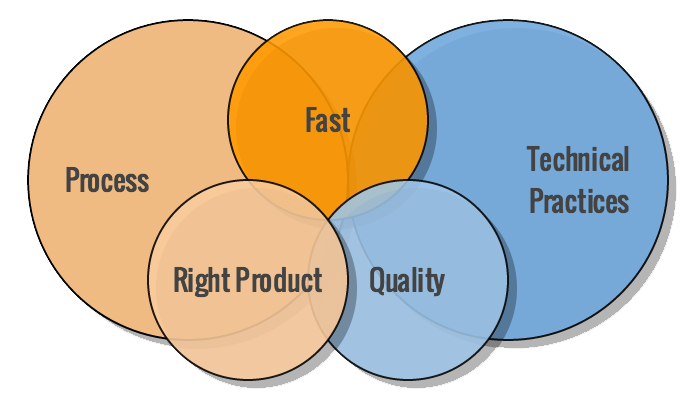The trend of IT and software organizations transitioning to Agile continues to grow. While Agile is a better way to get quality work done faster, the transition to Agile can be a weary road to travel. In this series, we’ll explore 10 of the most common pitfalls we see in Agile transformations and tips on how to overcome them. This week we will focus on pitfall #1.
Pitfall #1: Thinking Agile is Simply a Process Change
Ultimately, organizations who transition to Agile are trying to accomplish the same goals: they want to improve decision-making, pace of delivery and product quality.
While process plays a key part in these three factors, a true Agile transformation does not start or stop at processes. It involves technical practices, and together, these two items speak to a much larger facet of your organization: culture.

Processes vs. Practices
Process describes how you manage the work. The processes you have in place to handle everyday operations are largely responsible for your decision-making (choosing the right product) and pace of delivery.
Practice describes how you work. The practices your team engages in may be similar, but the way they go about implementing them can be different. Practices shine through in your product quality and, like processes, impact your team’s pace of delivery.
While practices and your processes impact your team’s pace of delivery, quality expectations, and decision-making, a transformation that only affects how you manage the work and how you do it is still an incomplete transformation.
The Distance between Doing Agile and Being Agile
Agile is more than a process transition: it is cultural. The transformation to Agile is not complete until your organization IS Agile. If your team is simply going through the motions of Agile (adjusting processes), they’re not reaping the full benefit of the methodology. The key is to have your organization living and breathing Agile, every step of the way.
If you’re midway through a transformation and not quite sure where you are on the doing to being spectrum, or if you’re reading this as a way of putting in some due diligence before taking the leap to Agile, I’d strongly suggest one activity that can help you get a clear picture of what it means to be Agile and to help you avoid this pitfall: look to others for guidance. To do this, take a field trip (we call it an Agile Safari). Find an organization you know is Agile, and ask if you can stop in for a day and find out how they tick. This is a great way to not only wrap your own mind around the Agile methodology but to get your team comfortable and on-board with it as well.
Not sure where you’re at on the spectrum from doing to being? Contact us today, or give us a call. We would love to connect with you and hear about your Agile Transformation.
Follow the entire series:
- Pitfall #2: No Guidance
- Pitfall #3: Not Providing Slack to learn
- Pitfall #4: Leadership Out Of Alignment
- Pitfall #5: Transparency Is Abused
- Pitfall #6: Lack of Feature Teams
- Pitfall #7: Not Improving Tech Practices
- Pitfall #8: Focusing Only on the Team
- Pitfall #9 & 10: Misalignment between the team, customers, and the IT enterprise organization
For more on our approach to building lasting business agility, you can check out our Transformation Services page.



